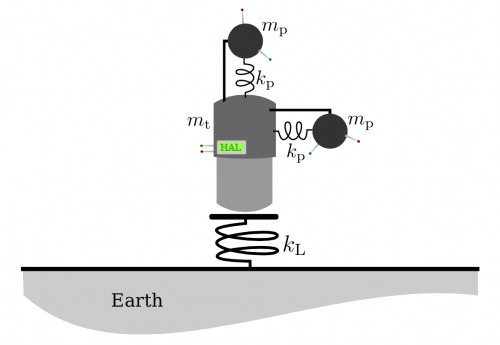Project 10: Learning issues
- Gravitational potential energy
- Spring potential energy
- Energy conservation
- Momentum conservation
Project 10: Part A: Launching a communications probe
How did the satellite from last week that contained HAL get launched? Prequel alert. You and your team are engineers that have been contracted by Elliot Carver of the Carver Media Group Network (CMGN) to plan the launch of their new “communications” satellite. The satellite is meant to perform a geosynchronous pole-to-pole orbit.
The satellite consists of a transmitter of mass ($m_t$ = 4500kg) connected to two perpendicularly directed ejectable spring-loaded probes (each having mass $m_p$ = 400kg). Each probe is connected to a single, very stiff spring ($k_p$ = $5.3\times10^9$ N/m). The probes can be ejected by remote control from the CMGN headquarters in Freer, Texas; springs can be compressed as needed. A mockup from CMGN's lead designer, Wai Lin, appears below.
CMGN is going green with their satellite launches. Their new design uses no fossil fuels. The satellite itself is launched from CMGN's launch facility in the South Pole with yet another spring system, oriented vertically with respect to the flat launching platform. This very stiff spring ($k_L$ = $8.3\times10^8$ N/m) can be compressed as needed.
The satellite contains a gyroscope that self-orients the satellite with respect to the gravitational force due to the Earth, such that the satellite remains in its original orientation throughout the entirety of its trip.
Carver needs you to plan the launch and any subsequent course corrections needed to get the satellite into a geosynchronous pole-to-pole orbit.
Project 10b: Joe and Blobs
You live on the planet Joe. Joe has a radius of 8432 Km and a mass of 6.822 × 10^26 kg. The industrial revolution on Joe has transpired differently than on Earth due to mainly the ability to construct springs of extremely large spring constants. The space program of the planet Joe is reliant on springs to send objects into orbit and for propulsion. However, the scientific community has recently moved to experiment with new forms of energy such as nuclear power. One of these experiments has been the sending of a nuclear-powered satellite (mass of 6900 kg) into orbit around Joe at a distance of 22,600 Km. However, issues have arisen with the coolant system of the satellite and it is in danger of exploding and releasing harmful radiation into the upper atmosphere of Joe. You must set the satellite on a path outside of the gravitational pull of Joe in order to save the day. To do so, you have the ability to fire large blobs of a putty-like substance from the surface of Joe. The biggest blob you have access to is of mass 5000kg. You also have access to a spring with a spring constant of 4.89*10^10 kg/s^2 to fire a blob to hit the satellite and send beyond the gravitational pull of Joe.
